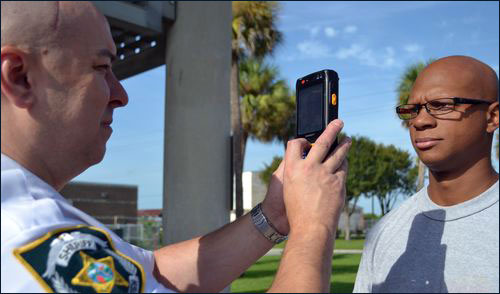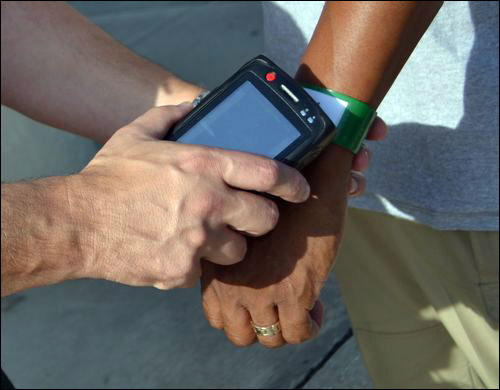Eight years ago, the 2004 Republican National Convention was held in New York City, attracting political protesters. Some of those individuals later filed lawsuits claiming they were falsely arrested by NYC police officers, or were detained for excessive lengths of time. The city is still seeking the dismissals of those suits, but in the meantime, the legal costs are adding up.
When the Hillsborough County Sheriff’s Office began planning for the 2012 Republican National Convention in Tampa, Fla. (which took place on Aug. 27-30), it wanted to ensure that if mass arrests became necessary, they would be tracked through the proper booking process. The department had already been using Codex Corp.‘s Guardian RFID solution (see Wristbands Document Interactions Between Prisoners and Officers) within its lockdown unit, and asked the company for a system that would enable it to track arrests and subsequent bookings.

In response, Codex Corp. developed the RFID Arrestee Management System (AMS), which is now being marketed to other agencies and government entities as a way to record when and where an individual was arrested, by which officer, the vehicle in which he or she was transported and where that person was booked—as well as every step of the booking process.
By the time this year’s Republican convention began, the Hillsborough County Sheriff’s Office had set up the AMS solution, utilizing its existing readers to access the Codex-hosted server that managed and displayed read data. The office also purchased approximately 1,500 RFID-enabled wristbands. As it turned out, by the time the convention had ended, only two arrests had been made in which the wristbands were used. The technology still proved that it worked, says Colonel James Previtera, a member of the Department of Detention Services for the Hillsborough County Sheriff’s Office. Previtera says he could see the sheriff’s office using the Arrestee Management System on a day-to-day basis if the county’s budget would allow it.
As part of the AMS solution, the wristband includes a 13.56 MHz Texas Instruments RFID tag compliant with the ISO 15693 standard, says Ken Dalley Jr., Codex Corp.’s president. As the system was designed, when a Tampa police officer made an arrest, he or she then turned the individual over to the sheriff’s office. At that time, the county officer fastened a wristband around that person’s wrist and used a Pidion Bluebird BIP-6000 handheld reader to interrogate the tag and photograph the individual. The officer also scanned the bar code of the arresting officer’s ID badge. That data was then forwarded to the back-end software residing on Codex’s cloud-based server, via a Wi-Fi connection, using a mobile hotspot connected to transport vans provided by the county.
The AMS software enabled the officer to use the reader’s touch screen to enter the location of the arrest, as well as the individual’s property at the time that the arrest occurred, such as a backpack or a purse. An RFID tag was also affixed to the back door of two buses on which individuals were to be loaded and then transported to the station. County officers used the interrogator to read the bus’ tag, along with the individual’s wristband tag, linking that person with that specific bus. The vehicle was also equipped with a GPS tracking unit, so that its location could be stored on the cloud-based server.
The arrestees were then transported to a transfer area, or were moved directly to jail. There, the staff employed a combination of handheld readers and RF IDeas desktop interrogators to identify every time that an individual underwent a procedure, such as having fingerprints or a mug shot taken. The sheriff’s office could then log into the AMS software to access information regarding how long a particular individual spent at each location, and to determine if he or she spent an excessive amount of time at any given area. Other actions could also be documented, such as removing the individual from the booking process to use the bathroom or receive another service. In these cases, staff members carrying handhelds could read the arrestee’s wristband tag and input information indicating which service was being provided, and by whom.
Although only two arrests occurred at the Republication National Convention, Previtera says, the technology provided confidence on the part of the sheriff’s office that it could manage a large number of arrests, if necessary. What’s more, he adds, it continues to be a useful tool. The county office had only to invest in the wristbands, as it was able to use the existing reader hardware. The office will pay for the AMS software only if it launches the system for day-to-day arrests or prisoner movements.

Additionally, the sheriff’s office utilized Codex technology to clock the hours of employees working overtime shifts throughout the event. Between 700 and 900 workers carried high-frequency (HF) Guardian RFID tags, Previtera explains, each containing a unique ID number linked to his or her name on the Codex server. An employee read the tag using one of the desktop readers upon arriving for work during the convention, and again at shift’s end. This data provided the office with necessary details pertaining to the hours each employee worked. This was important, he says, because the convention ended on Aug. 30, and the fiscal year ended on Sept. 30—thus, all payroll information had to be received by the county before the latter date.
Previtera says he believes the AMS solution will be slated for inclusion in the county’s 2014 budget. If the budget goes through as planned, he expects that the Hillsborough County Sheriff’s Office will use the technology for day-to-day arresting and the management of transported inmates, in order to document all of the processes that take place during each arrest or movement. “When you consider we move 450 inmates a day, you can see how the ability to track them would be helpful.” He adds that he could then use that information to improve operations if he were able to view where bottlenecks or delays commonly occur.
According to Dalley, the technology is now being marketed to other agencies, and the company is currently in discussions with another U.S. police agency about the solution.

